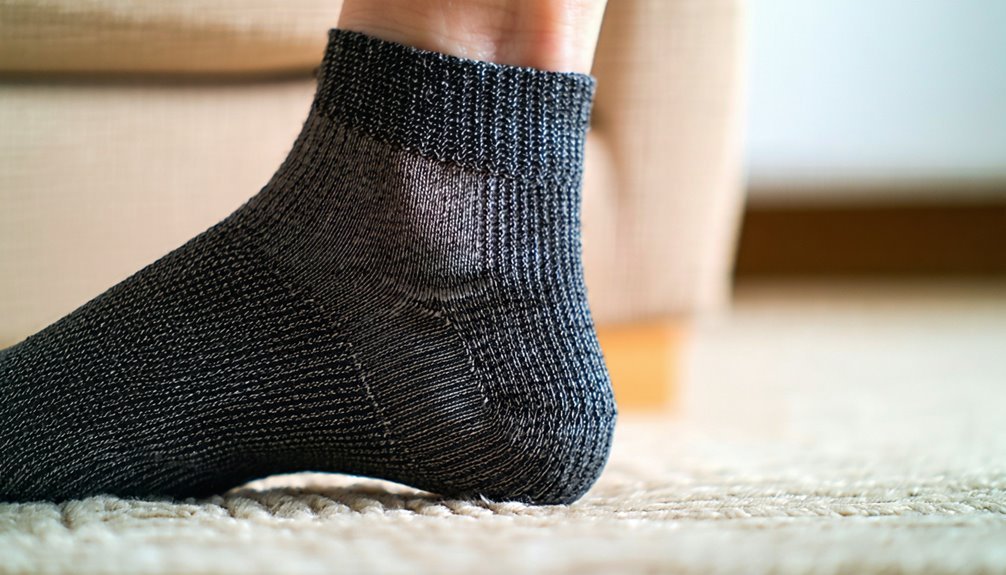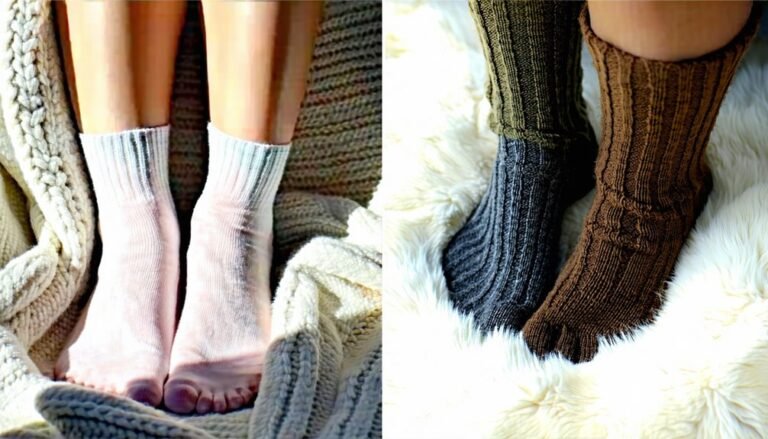Can Tight Socks Cut Off Circulation?
Tight socks can impede circulation, leading to potential health issues. They may cause numbness, tingling, or discoloration in your feet and toes, indicating restricted blood flow. Symptoms like indentations on your skin suggest a need for better-fitting socks to support venous return without unnecessary constriction. Choosing breathable fabrics and consulting sizing charts guarantees ideal circulation and comfort. It's essential to understand these effects to promote your vascular health and prevent complications. Discover more about proper sock fit next.
Understanding Sock Tightness and Its Effects

When considering the impact of sock tightness on circulation, it's vital to understand how compression affects blood flow. Socks that are too tight can impede venous return, potentially leading to discomfort and compromised circulation. Circulation education highlights that ideal sock comfort plays an important role in maintaining healthy blood flow. Properly fitted socks support the vascular system by applying balanced compression, which aids in preventing conditions like edema or varicose veins.
In your quest for safety, choose socks that offer gentle compression without constriction. This guarantees that your circulatory system functions effectively. Avoid overly tight bands that leave marks on your skin, as they may indicate restricted blood flow. Prioritize your well-being by selecting socks that enhance comfort and circulation simultaneously.
The Anatomy of Circulation in the Legs and Feet
Understanding how sock tightness affects circulation naturally leads us to examine the anatomy of circulation in the legs and feet. Your circulatory system in this area consists of arteries and veins that maintain arterial health and guarantee proper venous return. Arteries transport oxygen-rich blood from the heart to your legs and feet, while veins return deoxygenated blood back to the heart. The efficiency of this process is vital for overall limb health. If tight socks compress your legs, they can impede venous return, potentially causing discomfort or swelling. Furthermore, prolonged compression can affect arterial health by restricting blood flow. Therefore, it is important to choose socks that support your circulation without applying excessive pressure, prioritizing your safety and well-being.
How Tight Is Too Tight? Recognizing the Signs
Although it may seem subjective, determining how tight is too tight for socks involves recognizing specific clinical signs. You must pay attention to sock comfort and circulation awareness to guarantee your safety. Signs of socks being excessively tight include numbness, tingling, or discoloration in your toes or feet. These symptoms indicate compromised blood flow, which could escalate into more serious issues if not addressed.
Look for indentations or marks on your skin after removing socks, as these may suggest excessive constriction. If you experience persistent pain or swelling, it's essential to reconsider your sock choice or fit. Maintaining ideal sock comfort helps avoid circulation disturbances. Prioritizing these signs can safeguard your circulatory health, guaranteeing your socks support rather than hinder well-being.
The Role of Compression Socks: Beneficial or Harmful?

Can compression socks truly benefit your circulatory health, or do they pose potential risks? Compression socks can offer significant benefits when used correctly. They enhance venous return, reducing the risk of blood pooling and swelling. Here's how you can ascertain they're beneficial:
Compression socks, when used correctly, enhance venous return and reduce the risk of blood pooling and swelling.
- Compression Benefits: Choose socks with appropriate pressure levels, typically measured in mmHg, which supports your circulatory needs.
- Sock Selection: Ascertain proper fit by measuring your calf and ankle circumferences. Ill-fitting socks can cause discomfort.
- Gradual Compression: Opt for socks with graduated compression, which applies more pressure at the ankle and decreases upward.
- Consultation: Discuss with your healthcare provider to align sock selection with your medical history and conditions.
Adhering to these guidelines maximizes safety and therapeutic efficacy.
Potential Health Risks of Restricted Blood Flow
When blood flow is restricted, it can lead to several potential health risks that you should be aware of. Diminished blood flow can cause tissue damage, as cells rely on oxygenated blood to function effectively. If left unaddressed, prolonged restriction may result in ischemia, where tissues don't receive enough blood, possibly leading to necrosis. In addition, restricted blood flow can increase your risk of developing deep vein thrombosis (DVT), a serious condition where blood clots form in deep veins, often in the legs. These clots can travel, posing life-threatening risks like pulmonary embolism. Moreover, inadequate circulation may contribute to peripheral neuropathy, impairing nerve function. Understanding these health risks empowers you to make informed choices, ensuring your blood flow remains unrestricted for optimal health.
Symptoms of Impaired Circulation to Watch For
Experiencing symptoms of impaired circulation can be a crucial indicator of underlying health issues, and recognizing these signs early can prevent serious complications. By maintaining a symptoms checklist, you can identify circulation warnings and seek medical attention promptly. Watch for these signs:
Recognizing circulation symptoms early can prevent complications and ensure timely medical intervention.
- Tingling or Numbness: Persistent sensations in your extremities may indicate poor blood flow.
- Swelling: Edema in the legs or feet can signal vascular compromise.
- Cold Extremities: If your hands or feet feel unusually cold, it could reflect impaired circulation.
- Skin Changes: Look for discoloration or sores that heal slowly, which might suggest circulation issues.
Being attentive to these symptoms can protect your vascular health. If you notice any, consult a healthcare professional to guarantee your safety and well-being.
Factors Contributing to Sock-Induced Circulation Issues

You'll want to contemplate sock material and elasticity, as these factors markedly impact circulation. Evidence suggests that non-breathable fabrics or overly elastic bands can constrict blood flow, leading to discomfort or more serious issues. Ensuring proper sizing is essential, as ill-fitting socks can exacerbate pressure on your lower extremities, potentially compromising vascular health.
Sock Material and Elasticity
Although often overlooked, sock material and elasticity play a crucial role in circulation issues associated with tight socks. Understanding these elements can help you make safer choices. Here's what to take into account:
- Sock Elasticity: High elasticity can lead to constriction, compromising blood flow and causing discomfort. Opt for socks with moderate stretch to reduce pressure.
- Material Types: Natural fibers like cotton and wool offer breathability, reducing moisture buildup that can exacerbate tightness. Synthetic fibers may increase compression, so choose wisely.
- Compression Levels: Socks designed for medical compression have specific pressure ratings. Consult a healthcare provider to verify they're appropriate for you.
- Wear Duration: Prolonged wear of overly tight socks can lead to edema or other circulation complications. Regularly check for indentations or skin changes.
Prioritizing these factors helps maintain healthy blood circulation.
Proper Sizing Importance
Sock material and elasticity are important, but proper sizing greatly impacts circulation. When socks are too tight, they can restrict blood flow, leading to potential complications like numbness or even tissue damage. It's essential to pay close attention to sock sizing to maintain ideal foot health. Ill-fitting socks may exacerbate existing circulation issues, particularly for individuals with diabetes or peripheral artery disease.
To guarantee safety, always measure your foot size accurately before purchasing socks. Look for sizing charts and select options that offer a comfortable fit without excessive compression. Remember, socks should hug your foot gently without leaving deep marks on your skin. Prioritizing correctly sized socks can play a significant role in preventing circulation-related discomfort and promoting overall foot health.
Choosing the Right Fit: Tips for Optimal Comfort and Health
When selecting the right fit for socks, understanding how size and material affect circulation is essential for your comfort and health. Proper fit guarantees peak blood flow and prevents vascular constriction. Here are some evidence-based tips:
- Consult Sizing Charts: Always refer to sizing charts to match your foot dimensions accurately, reducing the risk of compression-related issues.
- Choose Appropriate Sock Materials: Opt for breathable materials like cotton or wool, which aid in moisture regulation and reduce the risk of skin irritation.
- Check Elasticity: Verify the sock's elasticity is sufficient to hold the sock in place without being too tight, which can impede circulation.
- Monitor Skin Changes: Regularly check for any signs of redness, swelling, or discomfort, which may indicate circulation problems.
Prioritize safety and comfort in your sock selection.
Special Considerations for Athletes and Active Individuals
For athletes and active individuals, selecting the right socks is essential to maintaining ideal performance and preventing injury. Performance socks are designed to provide optimal support and promote effective circulation during high-intensity activities. These specialized socks often incorporate materials like compression fabric, which can enhance venous return and reduce muscle fatigue. It's vital to guarantee that they fit correctly to avoid any restriction of blood flow, which can impede physical performance and increase the risk of injury. Post-activity, recovery wear plays a pivotal role in muscle recuperation. Socks designed for recovery can aid in reducing swelling and improving circulation, fostering quicker recovery times. Prioritizing the right fit and function in your socks can considerably contribute to your athletic success and health.
When to Seek Medical Advice for Circulation Concerns
If you experience persistent swelling and pain, numbness or tingling sensations, or notice discoloration or cold extremities, it's essential to seek medical advice promptly. These symptoms may indicate compromised circulation, potentially linked to underlying health conditions that require professional evaluation. Early intervention can prevent further complications and guarantee your vascular health is effectively managed.
Persistent Swelling and Pain
Although tight socks can seem like a minor inconvenience, persistent swelling and pain may indicate underlying circulation issues that warrant medical attention. Persistent inflammation and chronic discomfort are symptoms you shouldn't ignore. It's essential to monitor the following:
- Duration: If swelling and pain persist beyond a few days, it could signify a deeper issue.
- Severity: Severe pain or swelling may suggest compromised blood flow.
- Location: Swelling confined to one area, especially the legs or feet, can be a red flag.
- Accompanying symptoms: Look for redness, warmth, or skin changes alongside swelling and pain.
Seek medical advice to guarantee your circulation is functioning properly. Early intervention can prevent complications and promote vascular health, providing peace of mind and safety.
Numbness or Tingling Sensations
Experiencing numbness or tingling sensations in your extremities may signal potential circulation concerns that require medical evaluation. These sensations, often described as "pins and needles," can be alarming. Numbness causes might include pressure from tight socks that impede blood flow, constricting the nerves and leading to discomfort. It's vital to identify the underlying cause to prevent further complications. If you notice persistent or increasing numbness, seeking medical advice is essential to rule out serious conditions like peripheral neuropathy or vascular issues.
In the interim, consider tingling remedies such as loosening your socks, elevating your legs, or performing gentle exercises to enhance circulation. Prioritize your safety by monitoring symptoms closely and consulting healthcare professionals when necessary, ensuring your well-being remains protected.
Discoloration or Cold Extremities
Discoloration or cold extremities can be indicative of underlying circulation issues that warrant professional medical evaluation. It is crucial to identify potential causes early to prevent complications. Here are key signs when you should seek medical advice:
- Persistent Discoloration: Notice blue or purple hues? These discoloration causes might signal reduced blood flow.
- Cold Extremities: If your hands or feet feel persistently cold, it could indicate poor peripheral circulation.
- Swelling Accompanying Discoloration: This combination might suggest a vascular disorder needing prompt attention.
- Pain or Numbness: Discomfort alongside discoloration or cold extremities suggests possible nerve involvement or severe vascular issues.
Seek a healthcare professional to assess these symptoms, ensuring your safety and well-being. Early intervention can mitigate risks and promote vascular health.
Frequently Asked Questions
Can Tight Socks Cause Long-Term Damage to My Veins?
Yes, tight socks can affect vein health by restricting blood flow, potentially leading to long-term damage. Make certain your socks are comfortable and not too constrictive to maintain ideal circulation and protect your overall vascular health.
Are Certain Materials More Likely to Cause Circulation Issues?
You're concerned about material types, and rightly so. Fabrics with low elasticity, like pure cotton or wool, can restrict blood flow more than synthetic blends. Opt for materials with good elasticity to guarantee circulation safety and comfort.
How Do I Measure My Feet for the Correct Sock Size?
Measure twice, fit once. For foot measurement techniques, use a Brannock device or a tape measure. Guarantee accuracy by measuring both feet, then apply sock fitting tips, prioritizing comfort and safety to maintain ideal circulation and foot health.
Can Tight Socks Affect My Overall Energy Levels?
Tight socks can influence fatigue factors by potentially restricting blood flow, consequently impacting energy management. If you're noticing reduced energy levels, consider evaluating your sock fit as part of your strategy for effective energy management and overall well-being.
What Alternatives Exist for People With Sensitive Skin?
You'd think finding comfy socks isn't rocket science, but for sensitive skin, it can be. Consider compression alternatives with hypoallergenic fabric options, like bamboo or organic cotton, to guarantee you're stylishly safe and snug without sacrificing circulation.






